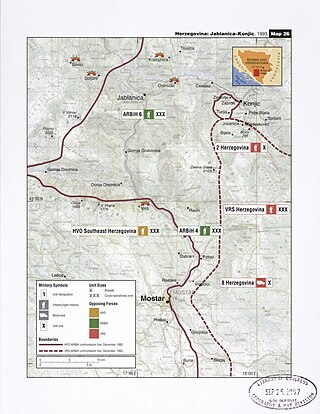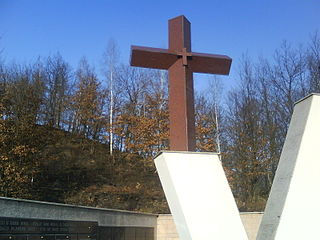
The Bosnian War was an international armed conflict that took place in Bosnia and Herzegovina between 1992 and 1995. The war is commonly seen as having started on 6 April 1992, following several earlier violent incidents. It ended on 14 December 1995 when the Dayton Accords were signed. The main belligerents were the forces of the Republic of Bosnia and Herzegovina, the Republic of Herzeg-Bosnia, and the Republika Srpska, the latter two entities being proto-states led and supplied by Croatia and Serbia, respectively.

The Ahmići massacre was the mass murder of approximately 120 Bosniak civilians by members of the Croatian Defence Council in April 1993, during the Croat–Bosniak War. The massacre was the culmination of the Lašva Valley ethnic cleansing committed by the political and military leadership of the Croatian Community of Herzeg-Bosnia. It was the largest massacre committed during the conflict between Bosnian Croats and the Bosniak-dominated Bosnian government.

Operation Neretva '93 was an Army of the Republic of Bosnia and Herzegovina (ARBiH) operation against the Croatian Defence Council (HVO) in September 1993 on a 200 km long front from Gornji Vakuf to south of Mostar, one of its largest of the year, during the Croat–Bosniak War. The ARBiH made limited gains in the area of northern Herzegovina and around Mostar, but did not achieve a breakthrough to the southern Neretva, where the HVO retained control. The operation was halted in October. During the operation, dozens of Croat civilians were killed in the Grabovica and Uzdol massacres.

The Lašva Valley ethnic cleansing, also known as the Lašva Valley case, refers to numerous war crimes committed during the Bosnian war by the Croatian Community of Herzeg-Bosnia's political and military leadership on Bosniak or Bosnian Muslim civilians in the Lašva Valley region of Bosnia-Herzegovina. The campaign, planned from May 1992 to March 1993 and erupting the following April, was meant to implement objectives set forth by Croat nationalists in November 1991. The Lašva Valley's Bosniaks were subjected to persecution on political, and religious grounds, deliberately discriminated against in the context of a widespread attack on the region's civilian population and suffered mass murder, rape and wartime sexual violence, imprisonment in camps, as well as the destruction of religious and cultural sites and private property. This was often followed by anti-Bosniak propaganda, particularly in the municipalities of Vitez, Busovača, Novi Travnik and Kiseljak.

The Croat–Bosniak War was a conflict between the internationally recognized Republic of Bosnia and Herzegovina and the so-called Croatian Republic of Herzeg-Bosnia, supported by Croatia, that lasted from 18 October 1992 to 23 February 1994. It is often referred to as a "war within a war" because it was part of the larger Bosnian War. In the beginning, the Army of the Republic of Bosnia and Herzegovina and the Croatian Defence Council (HVO) fought together in an alliance against the Yugoslav People's Army (JNA) and the Army of Republika Srpska (VRS). By the end of 1992, however, tensions between the Army of the Republic of Bosnia and Herzegovina and the Croatian Defence Council increased. The first armed incidents between them occurred in October 1992 in central Bosnia. The military alliance continued until early 1993, when it mostly fell apart and the two former allies engaged in open conflict.
The Dretelj concentration camp or Dretelj prison was a prison camp run by the Croatian Defence Forces (HOS) and later by the Croatian Defence Council (HVO) during the Bosnian War.
Operation Vrbas '92 was a military offensive undertaken by the Army of Republika Srpska in June–October 1992, during the Bosnian War. The goal of the operation was the destruction of a salient around the central Bosnian town of Jajce, which was held by the Croatian Defence Council and the Army of the Republic of Bosnia and Herzegovina. The intensity of fighting varied considerably and involved several major VRS offensive efforts interspersed by relative lulls in fighting. Jajce fell to the VRS on 29 October 1992, and the town's capture was followed by the destruction of all its mosques and Roman Catholic churches.

The Croat–Bosniak War was a conflict between the Republic of Bosnia and Herzegovina and the Croatian Community of Herzeg-Bosnia, supported by Croatia, that lasted from 19 June 1992 – 23 February 1994. The Croat-Bosniak War is often referred to as a "war within a war" because it was part of the larger Bosnian War.
The Mokronoge massacre was the mass killing of nine Bosniak civilians, in the village of Mokronoge, Tomislavgrad in Bosnia and Herzegovina. It was committed on 10 August 1993 by Ivan Baković, a soldier of the Croatian Defence Council (HVO) during the Croat-Bosniak War. In November 1999, the Municipal Court of Zagreb found Ivan Baković guilty in absentia and sentenced him to 15 year imprisonment. After Ivan Baković was arrested, he was also tried in the Cantonal Court in Livno and found guilty of war crimes committed against the civilian population. In 2004, he was sentenced to 15 year imprisonment.

The Križančevo selo massacre occurred in Križančevo selo, a hamlet in the Lašva Valley in central Bosnia, where at least 14 Croat POWs and civilians were killed during an attack by the Army of the Republic of Bosnia and Herzegovina (ARBiH) on Croatian Defence Council (HVO) positions on 22 December 1993.
The Bijeli Potok massacre refers to the mass killing of 675 Bosniak civilians by Serbs on 1 June 1992 in the settlement Bijeli Potok within the village Đulići, located in the municipality of Zvornik, Bosnia and Herzegovina. About 675 Bosniak men and boys, from the multiple villages around Zvornik, were separated from their families by Serb forces, and slaughtered within a week at Bijeli Potok and their bodies hidden in mass graves throughout the Drina Valley.
The Battle of Bugojno was fought between forces of the Army of the Republic of Bosnia and Herzegovina (ARBiH) and the Croatian Defence Council (HVO) for control of the town and municipality of Bugojno in central Bosnia, from 18–28 July 1993. The area of Bugojno was under joint control of the ARBiH 307th Brigade and the HVO Eugen Kvaternik Brigade since the start of the Bosnian War. Violent incidents in Bugojno followed the escalation of the Croat-Bosniak War in adjacent municipalities throughout the 1st half of 1993. Bugojno was spared from fighting and the two local brigades were still formally allied by June 1993, at the time of an ARBiH offensive in central Bosnia.
The Uzdol massacre refers to the murders of at least 25 ethnic Croat inhabitants of the village of Uzdol by members of the Army of the Republic of Bosnia and Herzegovina (ARBiH) on 14 September 1993, during Operation Neretva '93, part of the Croat-Bosniak War.
The Battle of Prozor is one of the first battles in the Croat–Bosniak war, the battle ended with the victory of the HVO. Just as UNPROFOR was dousing the last of the embers in Novi Travnik, a conflagration was about to begin in Prozor, some 40 km directly to the south. Prozor was an unassuming town of about 15,000 Croats and Muslims, far from the frontlines and noteworthy only because it had the fortune or misfortune to sit astride the main north-south highway in Bosnia, running from the sea at Ploče to Mostar and Jablanica, through Prozor to Gornji Vakuf, and on to Jajce and western Bosnia. Fighting began in Prozor on 23 October as a gangland dispute over which mafia organization would receive a delivery of black-market gasoline.
The Kiseljak massacre was the mass murder of approximately 78 Bosniak civilians by members of the Croatian Defence Council in June 1993, during the Croat–Bosniak War. The massacre was committed by the political and military leadership of the Croatian Community of Herzeg-Bosnia. It was the second largest massacre committed by Croats during the Croat–Bosniak War.
The massacre in Vrbanja is the name for a war crime committed by the Croatian Defence Council (HVO) against Bosniak civilians in the village of Vrbanja from July 17 to 28, 1993, during the Croat-Bosniak War.
The Here massacre is the name for a war crime committed by the Croatian Defence Council (HVO) against Bosniak civilians in the village of Here on 24 January 1994, during operation Tvigi 94, of the Croat-Bosniak War.
The Raštani massacre is the name for a war crime committed by the Croatian Defence Council (HVO) against Bosniak civilians in the village of Raštini near Mostar during the Croat-Bosniak War. The Raštani massacre took place in the early morning of 24 August 1993, after several hours of artillery fire, HVO units invaded the settlement and massacred 31 Bosniaks.
The Orašlje massacre was the mass murder of approximately 15 Bosniak civilians by members of the Croatian Defence Council in June 1993, during the Croat–Bosniak War. There was a massacre at the same place committed by the Ustaše and the Germans 50 years before this one.






